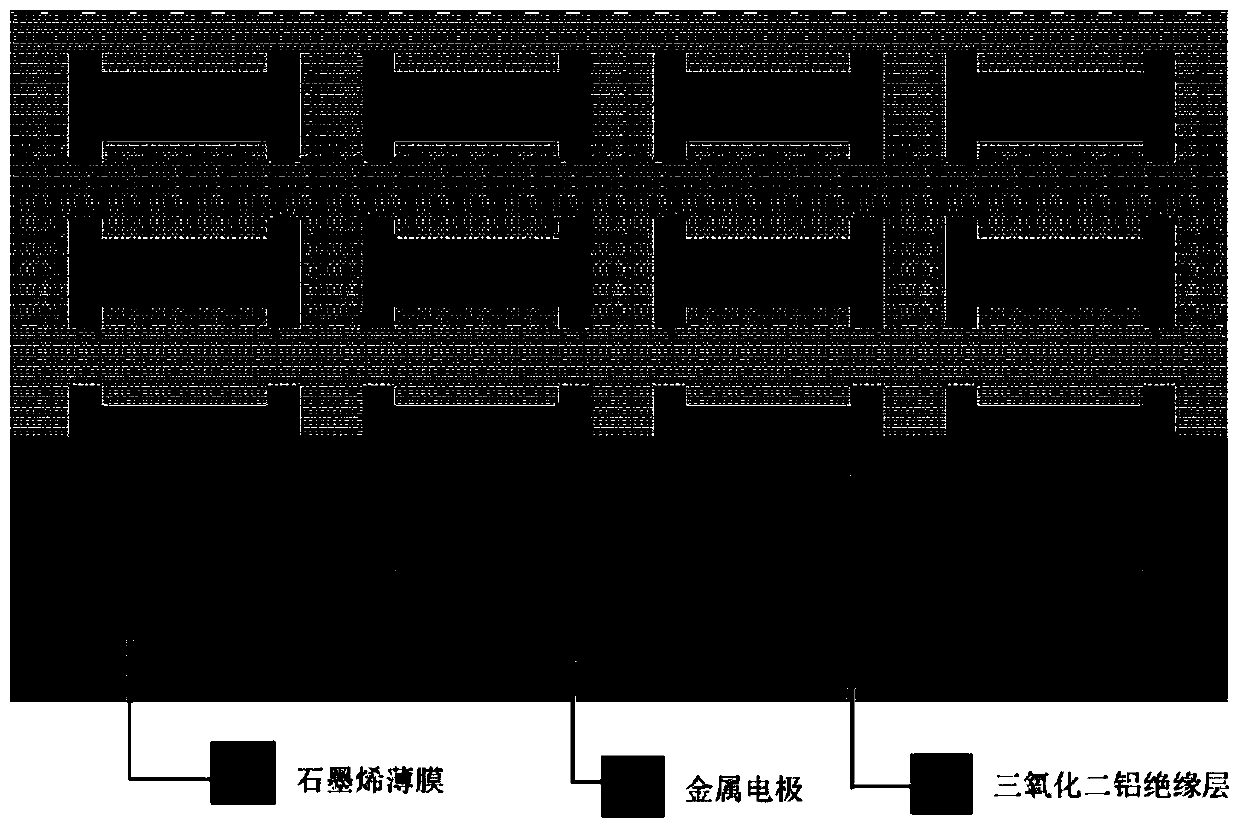Electro-thermal radiation light emitting array device and preparation method and application thereof
A light-emitting array and thermal radiation technology, applied in the direction of electroluminescent light source, electric light source, electrical components, etc., can solve the problems of easy oxidation of graphene and complicated preparation process, and achieve easy silicon-based process integration, high resolution, The effect of good application prospects
- Summary
- Abstract
- Description
- Claims
- Application Information
AI Technical Summary
Problems solved by technology
Method used
Image
Examples
Embodiment 1
[0049] A method for preparing an electrothermal radiation light-emitting array device, which comprises the following steps:
[0050] S1. Transfer the graphene film to the surface of the silicon wafer:
[0051] S11, spin-coating a polymethyl methacrylate solution layer on the surface of the graphene layer based on the metal foil, and drying;
[0052] S12. After the polymethyl methacrylate is cured, use (NH 4 ) 2 S 2 o 8 Solution etching to remove the metal foil substrate;
[0053] S13, the obtained graphene film having a polymethyl methacrylate layer on the surface is cleaned in deionized water and then picked up with a base silicon wafer and dried;
[0054] S14, using acetone to dissolve the polymethyl methacrylate layer;
[0055] S15. Place the graphene film on the silicon wafer treated in step S14 in a mixture of argon and hydrogen for annealing at 200° C. to remove residual polymethyl methacrylate and solvent acetone on the surface of the graphene.
[0056] S2. Etchi...
Embodiment 2
[0073] The application of the electrothermal radiation light emitting array device obtained in Example 1 in integrated high-speed optical communication, the electrothermal radiation light emitting array device is used as a high-speed, ultra-small light source on a silicon chip.
[0074] Connect the electrode of the light-emitting array device to the external circuit through a conductive metal wire by using an ultrasonic pressure welding machine, one end of the electrode is grounded, the other end is connected to a voltage source, and the scanning bias voltage is set to 0V to 30V;
[0075] Using InGaAs-based and Si-based CCD spectrometers to measure the radiative luminescence spectrum of the light-emitting array device under the action of bias voltage, the radiative spectrum is shown in the attached image 3 shown. From the radiation spectrum diagram, we can see that with the increase of the applied source-drain bias voltage, the intensity of the radiation spectrum changes sign...
Embodiment 3
[0079] Application of the electrothermal radiation luminescence array device obtained in Example 1 in an infrared thermal imaging system. The electrothermal radiation emission array device is used for infrared target imaging, and its advantages lie in high resolution and high frame rate. Compared with traditional The silicon-based resistor array analog imaging technology overcomes the shortcomings of the latter, such as slow temperature change, limited temperature range, and multi-spectral range, and can realize infrared target imaging such as simulated high-speed motion and full-band radiation.
PUM
| Property | Measurement | Unit |
|---|---|---|
| thickness | aaaaa | aaaaa |
| thickness | aaaaa | aaaaa |
| thickness | aaaaa | aaaaa |
Abstract
Description
Claims
Application Information
 Login to View More
Login to View More - R&D
- Intellectual Property
- Life Sciences
- Materials
- Tech Scout
- Unparalleled Data Quality
- Higher Quality Content
- 60% Fewer Hallucinations
Browse by: Latest US Patents, China's latest patents, Technical Efficacy Thesaurus, Application Domain, Technology Topic, Popular Technical Reports.
© 2025 PatSnap. All rights reserved.Legal|Privacy policy|Modern Slavery Act Transparency Statement|Sitemap|About US| Contact US: help@patsnap.com



